Instruction
Ben Hogan’s Timeless Tips
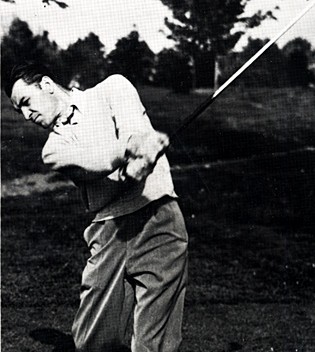
Advice from the legendary ball-striker that ran in Golf Digest through the years
By Alex Myers
Follow on Twitter: @AlexMyers3
December 2011
Read More http://www.golfdigest.com/golf-instruction/2011-10/photos-hogan-timeless-tips#ixzz1gT2sNEyW
In an article on how to hit the ball farther, Hogan emphasized acceleration on the downswing, but more through following a certain sequence of movements than by merely trying to swing hard. Hogan believed following the proper chain of events (hips, then shoulders, then arms and hands) built up more energy. Once you start from the top in that particular order, he said to “execute the remainder of the downswing with gradually increasing tempo” so that the club is traveling its fastest just after impact.
Golf Digest Resource Center
Accelerate through impact (Summer, 1950)
When possible, Hogan preferred to play low chip/pitch shots with spin, since he felt they were easier to control. To do this, he instructed golfers to keep their hands in front of the ball and low through impact. He said to keep actual hand movement to a minimum in order to avoid trying to scoop the ball.
Think Low Around The Greens (Early Summer, 1951)
When possible, Hogan preferred to play low chip/pitch shots with spin, since he felt they were easier to control. To do this, he instructed golfers to keep their hands in front of the ball and low through impact. He said to keep actual hand movement to a minimum in order to avoid trying to scoop the ball.
Make a proper weight shift for crisper contact (May, 1952)
Dallas Jones Studio, Chicago
Hogan thought one of the amateur golfer’s most-common flaws is that they hit the ground before hitting the ball when using their irons. To hit down on the ball properly, he suggested golfers focus on shifting their weight to their front side on the downswing. That move will keep a person from feeling like they are falling back at impact, and it help ensures a golfer will “take turf” after making contact with the ball.
Store Up Your Power (June, 1954)
Golf Digest Resource Center
Hogan’s accuracy was his biggest trademark, especially off the tee. But while he rarely missed fairways, he was also one of the longest hitters of his era. To accomplish both, he keyed on delaying his wrist action during the downswing. The result was his famous lag in which he allowed the clubhead to fall well behind the hands — a move that is probably most closely replicated today by Sergio Garcia.
Pronate To Fade (February, 1956)
AP Photo
After years of struggling with hooking the ball, Hogan discovered a way to cut that dreaded shot out of his game completely by hitting, well, a cut. He did this by pronating his left wrist (turning the palm down) as he took the club back and then cupping it (both part of his famous “secret” he revealed in a Life Magazine article in 1955) at the top. The move got the clubface so open, that no matter how hard he swung coming down, he avoided shutting it too much. The result was a consistent, high, left-to-right ball flight that he relied on to win nine major championships.
Flatten your lead wrist at impact (April, 1956)
Golf Digest Resource Center
Hogan was very rigid in his belief that golfers needed to follow closely a series of proper fundamentals to have a sound swing. However, one thing that jumped out at him when comparing a good ball-striker to a hack is the position of the leading wrist (the left wrist for a right-handed player) at impact. Hogan thought the wrist should supinate or be bowed out toward the target at impact, whereas someone making poorer contact usually pronates their leading wrist into a weaker position. He felt this allowed for crisper contact, while de-lofting the club for more distance.
Don’t Overlook The Grip (October, 1960)
Hogan’s famous instructional book, “Five Lessons,” begins with a chapter on fundamentals, specifically, the grip, which he thought was the foundation of any good golf swing. In an excerpt of the book in the magazine, he demonstrates how one should grip the club and stresses that both hands must be firmly on the club and work together as one unit. “They can’t if you grip the club almost correctly — which really means partially incorrectly,” Hogan
Think Swing Plane instead of swing arc (June, 1985)
Golf Digest Resource Center
In a rare interview with an older Hogan, the golf legend demonstrates his swing and firmly states the advice he gives in his book “Five Lessons”, have held up over time. “I would write it the same way I did in 1957. Everything I know about the full swing is in here. I don’t think the fundamentals will ever change.” One lesson he revisits in particular is that every swing has two planes — one for the backswing and a slightly shallower one for the downswing. His tip to nail this down is to “visualize the backswing plane as a large pane of glass that rests on the shoulders, as it inclines upward from the ball.” Hogan says the plane of the backswing “should remain parallel with the pane to the top of the backswing,” before getting into the shallower downswing. At no point should the club cross through the plane and break the imaginary glass.
Read More http://www.golfdigest.com/golf-instruction/2011-10/photos-hogan-timeless-tips#ixzz1gSzO2o8h
- LIKE26
- LEGIT3
- WOW1
- LOL2
- IDHT1
- FLOP0
- OB0
- SHANK0
Instruction
Clement: Laid-off or perfect fade? Across-the-line or perfect draw?

Some call the image on the left laid off, but if you are hitting a fade, this could be a perfect backswing for it! Same for across the line for a draw! Stop racking your brain with perceived mistakes and simply match backswing to shot shape!
- LIKE0
- LEGIT0
- WOW0
- LOL0
- IDHT0
- FLOP0
- OB0
- SHANK1
Instruction
The Wedge Guy: The easiest-to-learn golf basic

My golf learning began with this simple fact – if you don’t have a fundamentally sound hold on the golf club, it is practically impossible for your body to execute a fundamentally sound golf swing. I’m still a big believer that the golf swing is much easier to execute if you begin with the proper hold on the club.
As you might imagine, I come into contact with hundreds of golfers of all skill levels. And it is very rare to see a good player with a bad hold on the golf club. There are some exceptions, for sure, but they are very few and very far between, and they typically have beat so many balls with their poor grip that they’ve found a way to work around it.
The reality of biophysics is that the body moves only in certain ways – and the particulars of the way you hold the golf club can totally prevent a sound swing motion that allows the club to release properly through the impact zone. The wonderful thing is that anyone can learn how to put a fundamentally sound hold on the golf club, and you can practice it anywhere your hands are not otherwise engaged, like watching TV or just sitting and relaxing.
Whether you prefer an overlap, interlock or full-finger (not baseball!) grip on the club, the same fundamentals apply. Here are the major grip faults I see most often, in the order of the frequency:
Mis-aligned hands
By this I mean that the palms of the two hands are not parallel to each other. Too many golfers have a weak left hand and strong right, or vice versa. The easiest way to learn how to hold the club with your palms aligned properly is to grip a plain wooden ruler or yardstick. It forces the hands to align properly and shows you how that feels. If you grip and re-grip a yardstick several times, then grip a club, you’ll see that the learning curve is almost immediate.
The position of the grip in the upper/left hand
I also observe many golfers who have the butt of the grip too far into the heel pad of the upper hand (the left hand for right-handed players). It’s amazing how much easier it is to release the club through the ball if even 1/4-1/2″ of the butt is beyond the left heel pad. Try this yourself to see what I mean. Swing the club freely with just your left hand and notice the difference in its release from when you hold it at the end of the grip, versus gripping down even a half inch.
To help you really understand how this works, go to the range and hit shots with your five-iron gripped down a full inch to make the club the same length as your seven-iron. You will probably see an amazing shot shape difference, and likely not see as much distance loss as you would expect.
Too much lower (right) hand on the club
It seems like almost all golfers of 8-10 handicap or higher have the club too far into the palm of the lower hand, because that feels “good” if you are trying to control the path of the clubhead to the ball. But the golf swing is not an effort to hit at the ball – it is a swing of the club. The proper hold on the club has the grip underneath the pad at the base of the fingers. This will likely feel “weak” to you — like you cannot control the club like that. EXACTLY. You should not be trying to control the club with your lower/master hand.
Gripping too tightly
Nearly all golfers hold the club too tightly, which tenses up the forearms and prevents a proper release of the club through impact. In order for the club to move back and through properly, you must feel that the club is controlled by the last three fingers of the upper hand, and the middle two fingers of the lower hand. If you engage your thumbs and forefingers in “holding” the club, the result will almost always be a grip that is too tight. Try this for yourself. Hold the club in your upper hand only, and squeeze firmly with just the last three fingers, with the forefinger and thumb off the club entirely. You have good control, but your forearms are not tense. Then begin to squeeze down with your thumb and forefinger and observe the tensing of the entire forearm. This is the way we are made, so the key to preventing tenseness in the arms is to hold the club very lightly with the “pinchers” — the thumbs and forefingers.
So, those are what I believe are the four fundamentals of a good grip. Anyone can learn them in their home or office very quickly. There is no easier way to improve your ball striking consistency and add distance than giving more attention to the way you hold the golf club.
More from the Wedge Guy
- The Wedge Guy: Golf mastery begins with your wedge game
- The Wedge Guy: Why golf is 20 times harder than brain surgery
- The Wedge Guy: Musings on the golf ball rollback
- LIKE86
- LEGIT13
- WOW6
- LOL1
- IDHT0
- FLOP4
- OB1
- SHANK8
Instruction
Clement: Stop ripping off your swing with this drill!

Not the dreaded headcover under the armpit drill! As if your body is defective and can’t function by itself! Have you seen how incredible the human machine is with all the incredible feats of agility all kinds of athletes are accomplishing? You think your body is so defective (the good Lord is laughing his head off at you) that it needs a headcover tucked under the armpit so you can swing like T-Rex?
- LIKE0
- LEGIT2
- WOW2
- LOL0
- IDHT0
- FLOP0
- OB0
- SHANK2
-

 19th Hole2 weeks ago
19th Hole2 weeks agoDave Portnoy places monstrous outright bet for the 2024 Masters
-

 19th Hole3 days ago
19th Hole3 days agoJustin Thomas on the equipment choice of Scottie Scheffler that he thinks is ‘weird’
-

 19th Hole2 weeks ago
19th Hole2 weeks agoTiger Woods arrives at 2024 Masters equipped with a putter that may surprise you
-

 19th Hole3 days ago
19th Hole3 days ago‘Absolutely crazy’ – Major champ lays into Patrick Cantlay over his decision on final hole of RBC Heritage
-

 19th Hole2 weeks ago
19th Hole2 weeks agoTwo star names reportedly blanked Jon Rahm all week at the Masters
-

 19th Hole1 week ago
19th Hole1 week agoReport: LIV Golf identifies latest star name they hope to sign to breakaway tour
-

 19th Hole1 week ago
19th Hole1 week agoNeal Shipley presser ends in awkward fashion after reporter claims Tiger handed him note on 8th fairway
-

 19th Hole1 week ago
19th Hole1 week agoBrandel Chamblee has ‘no doubt’ who started the McIlroy/LIV rumor and why

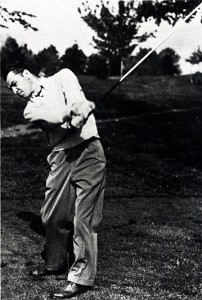
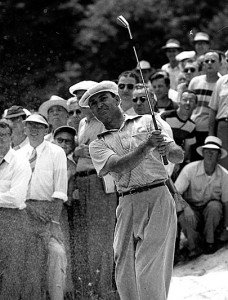
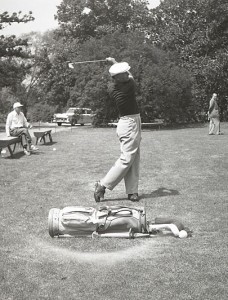
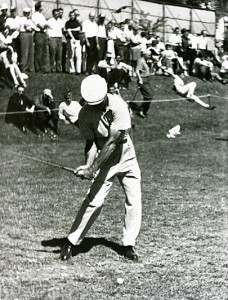
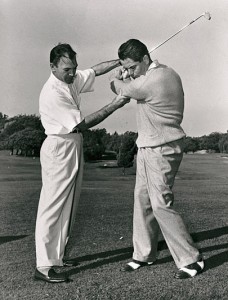
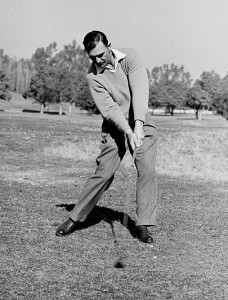
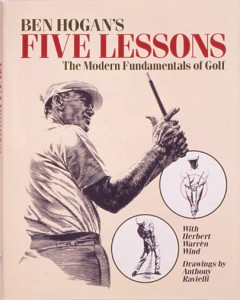
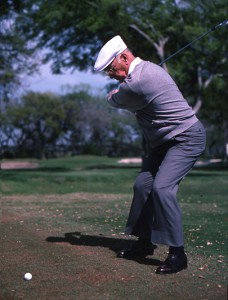















mike
Feb 15, 2013 at 3:39 pm
In regards to Hogan’s closed stance. It usually promotes a right to left shot. Look at Fred Couples. He has a open stance and he draws the ball right to left. Open stances most of the time create a fade(left to right). What ever works the best for the individual golfer is most important. That is why you see all different types of swings on the PGA tour. They all have one thing in common. They square the club face at impact and 95% of the weekend golfers do not. Having a simple swing for a amateur golfer that can be repeated time and time again is best suited for them. Hogan tries to instill this in his teaching. Hogan’s book helped me in a lot of ways but I ended up making changes in my swing that allowed me to have a repeated golf swing I could rely on. Not exactly like Hogan’s of course but with his teachings in mind.
Jose Nunya
Feb 23, 2014 at 7:10 am
If you play enough golf you can have just about any type swing you’ like. If you’d like to work a regular job, raise a family and be able to shoot in the 80’s you should probably have a fundamentally sound swing. Anybody can hack it up and some even have fun. I just hope they aren’t playing in the 4 some in front of me.
scott rank
Jan 8, 2012 at 2:42 am
Rod,
You are crazy if you think hand action manages ball flight.
buteman
Jan 7, 2012 at 6:56 am
Excellent comment W.U. I have Hogan’s book and refer to it often in the off season. I firmly believe there are very few amateur golfers that could emmulate Hogan’s swing.
The three chapters that would be of great help to golfers especially novice golfers are the Grip, Stance and Posture chapters.
Those three fundamentals are of the utmost importance and I believe that most amateur golfers easily bypass those fundamentals and focus on golf swings that can not be properly executed with poor basic set ups.
Also ( in my humble opinion ) it would take years of practice to perfect what Hogan states is the proper sequence in the downswing.
Let’s not forget, the approximate time from start to finish when hitiing a ball with a driver is 6-7 seconds.
How would the average guy learn to make those moves in that period of time when their principal concern is where the ball is going.
On a final note, Hogan fought the hook for years but I find it quite incredible that when he set up he did so continually with a closed stance which as we both know simply encourages a right to left shot.
Regards,
buteman.
AndyG
Mar 30, 2013 at 3:22 am
Mr Hogan, may have had his right foot slightly back at address but he’s shoulders hips were all square to target.
Most of us who try to copy that stance have our hips matching our foot line stance too, promoting that right to left flight.
Rod_cccgolfusa
Jan 2, 2012 at 10:59 am
Hogan’s teaching can be better understood through the perspective of Henry Cotton, the Open champion. Cotton made a strong case for understanding how the grip and hand action were to be used in managing the flight of the ball. This aspect of instruction seems to have been lost in the infatuation with driving distance.
W.U.
Dec 23, 2011 at 10:35 am
The Myth of Ben Hogan’s swing: people are so in awe of his swing, but in reality, his swing was quite un-conventional. He made it work for him, but a lot of people would find it hard to copy it, as it had its own quirks.
One, he never turned his shoulders fully. You can see from his heyday in 53 or 54, when they filmed him, his left shoulder never made it all the way down to his chin – not even close. He never made a full shoulder turn. Instead, he had long arms for a short guy, and he was also also able to literally be “Gumby” with his arms and his wrists, with which he had extra flexibility.
Two, he stood closed. His feet were always set up closed, the longer the club! Which is a totally uncomfortable for most, it would make most players hook it. It’s completely against conventional wisdom to stand shut to target. You would think we have to stand parallel to target – but not Hogan. But that is how Hogan liked to make it look like he was making an extra wide turn with his hips, by standing closed. And in fact, it also meant that he had a very flexible torso, hips and thighs. He could literally weight-shift to his left side and stretch the left side all the way UP high and finish with a long stretch of his rib cage – most people can’t stretch like that, that is why most people tend to rebound or fall backwards.
Three – he switched from an uncontrollable draw-hook to a cut-fade and that is how he conquered Carnoustie and became a legend. In order to change his ball flight, he changed his grip until he bled. He taught himself to hold off longer down the line and finish higher in order to pulling it over his left shoulder to stop hooking it.
Don’t be deceived by the myth – he was only 5’7″ with extra long arms for a short man, and he made his physicality work for him. His Five Lessons can only be applied to some, it’s not for everybody.